Comment changer l'emplacement de sauvegarde iTunes
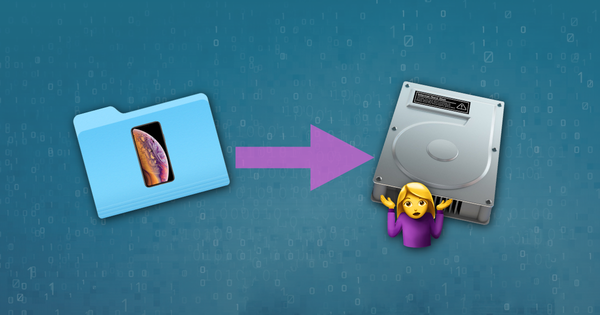
L'emplacement de sauvegarde iTunes par défaut est défini sur le disque principal du PC ou du Mac. Dans macOS 10.15, les sauvegardes iOS créées par le Finder sont stockées au même endroit. De nombreux utilisateurs ont des sauvegardes volumineuses ou des sauvegardes à partir d'un certain nombre de périphériques iOS et, par conséquent, ils se retrouvent à court d'espace disque.
Il est possible de configurer un ordinateur de manière à ce qu'iTunes sauvegarde sur un disque dur secondaire ou sur un disque dur externe ou un NAS.
En termes simples, cela se fait en remplaçant le dossier de sauvegarde iTunes par un lien symbolique vers l'emplacement souhaité. Cette modification est facilement réversible. Il est donc possible de restaurer l’emplacement de sauvegarde par défaut dans son répertoire d’origine.
Veuillez noter que si l'emplacement de sauvegarde iTunes est remplacé par un volume qui n'est pas disponible à tout moment, le processus de sauvegarde iTunes échouera lorsque le nouvel emplacement est indisponible.
Ce dont vous aurez besoin
Pour modifier l’emplacement de sauvegarde iTunes par défaut de votre ordinateur, vous devez disposer des éléments suivants:
- Compétence moyenne avec un PC ou un Mac
- 10 minutes
- Compréhension du nouveau chemin d’emplacement de sauvegarde souhaité
- Mac fonctionnant sous MacOS 10.7 ou plus récent ou PC sous Windows Vista ou plus récent
- L'équipe d'assistance de Reincubate est à votre disposition pour vous aider et peut conseiller les clients sur la procédure à suivre.
Changer le dossier de sauvegarde iTunes iOS automatiquement
La version gratuite d'iPhone Backup Extractor vous indiquera automatiquement l'emplacement de sauvegarde iTunes par défaut de votre ordinateur et vous permettra de le modifier.
- Téléchargez et installez iPhone Backup Extractor .
- Choisissez
Preferencesdans le menu principal - Sélectionner
BackupsduPreferencesla fenêtre![Le volet "Préférences" affichant les emplacements de sauvegarde The "Preferences" pane showing backup locations]()
Le volet "Préférences" affichant les emplacements de sauvegarde - Cliquez sur le bouton
Changepour lancer le processus de modification de votre dossier de sauvegarde par défaut iTunes.
Modification manuelle du dossier de sauvegarde iTunes iOS sous Windows
- Open the default Backup location in Explorer using the Windows Run command. Press
⊞ Win+Rand the Run window should appear. For Windows 7, 8 and Windows 10 iTunes Apple version, enter%APPDATA%\Apple Computer\MobileSyncand press⏎ Enter. For iTunes Microsoft Store version, enter\Users\[USERNAME]\Apple\MobileSync\Backup, where[USERNAME]is your Windows user name. - La fenêtre de l'explorateur qui s'ouvre affichera un dossier nommé "Sauvegarde". Cela contient toutes les sauvegardes iTunes déjà présentes sur l'ordinateur. Afin de changer l'emplacement du dossier de sauvegarde, ce dossier doit être renommé, déplacé ou supprimé. Par exemple, on pourrait le renommer "Sauvegarde (ancienne)".
- Une fois que le dossier "Sauvegarde" a été renommé, déplacé ou supprimé, un lien symbolique peut être créé vers l'emplacement de sauvegarde souhaité. Pour ce faire, une fenêtre de commande doit être ouverte. En maintenant la
⇧ Shiftet en cliquant avec le bouton droit de la souris dans la fenêtre de l'explorateurMobileSyncrécemment ouverte, les utilisateurs verront un menu avec l'option "Ouvrir la fenêtre de commande ici" ou "Ouvrir la fenêtre PowerShell ici". Cliquez dessus. - Utilisez la commande suivante
mklink /d Backup "[desired-new-backup-path]". Une fois cette commande entrée, appuyez sur⏎ Enteret la modification sera terminée. - Après avoir redémarré Windows, iTunes stockera ses sauvegardes au nouvel emplacement.
Modification manuelle du dossier de sauvegarde iTunes iOS sur macOS
- Lancez l'application MacOS Terminal. Cela peut être trouvé en utilisant le Finder, sous
Applications / Utilities / Terminal. Vous pouvez également lancer Spotlight en appuyant sur⌘ Cmd+.et en tapant "Terminal" avant d'appuyer sur⏎ Enter. - Demandez au terminal de changer l'emplacement de sauvegarde par défaut d'iTunes en entrant
cd ~/Library/Application\ Support/MobileSync, puis en appuyant sur⏎ Enter. - Révéler le dossier de sauvegarde actuel dans le Finder en entrant
open .puis en appuyant sur⏎ Enter. - La fenêtre du Finder qui s'ouvre affichera un dossier nommé "Sauvegarde". Cela contient toutes les sauvegardes iTunes déjà présentes sur l'ordinateur. Afin de changer l'emplacement du dossier de sauvegarde, ce dossier doit être renommé, déplacé ou supprimé. Par exemple, on pourrait le renommer "Sauvegarde (ancienne)".
- Une fois que le dossier "Sauvegarde" a été renommé, déplacé ou supprimé, un lien symbolique peut être créé vers l'emplacement de sauvegarde souhaité. Utilisez la commande suivante
ln -s [desired-new-backup-path] ~/Library/Application\ Support/MobileSync/Backup. Une fois cette commande entrée, appuyez sur⏎ Enteret la modification sera terminée. - Après avoir redémarré le Mac, iTunes stockera ses sauvegardes au nouvel emplacement.
Comment restaurer le dossier de sauvegarde iTunes à son emplacement d'origine
Si vous avez suivi les étapes ci-dessus et que vous souhaitez annuler le changement, le processus est simple:
- Accédez au dossier de sauvegarde iTunes .
- Supprimez le lien symbolique
Backupqui y apparaîtra. - Faites glisser votre dossier de
Backuporigine, en le renommant si nécessaire pour correspondre à son nom d'origine.
Autres défis?
Certains utilisateurs qui ont déjà déplacé leur dossier de sauvegarde iTunes vers un autre emplacement (simplement en le faisant glisser) n'ont plus le lien symbolique nécessaire pour qu'iTunes puisse voir la sauvegarde.
C'est facile à résoudre, et il y a deux options:
Faites glisser le dossier à l'endroit où vous avez trouvé à l'origine. Si vous avez oublié, vous devez le nommer
Backup. Il se trouve dans~/Library/Application Support/MobileSync.Créez un lien symbolique pointant vers celui-ci - de la même manière que décrit dans les instructions ci-dessus. Si vous êtes à cette étape, vous devriez ouvrir un terminal et procédez comme suit:
cd [location of the folder which now has "Backup" in it] ln -s Backup ~/Library/Application\ Support/MobileSync
Cela devrait être aussi simple que cela.
Y a-t-il des situations où ce n'est pas possible?
Cette technique fonctionne sur tous les Mac, mais pas sur les PC Windows construits avant 2000. Avant la publication de Windows 2000, Windows utilisait par défaut des systèmes de fichiers au format FAT , qui ne pouvaient pas créer de lien symbolique. Toute version de PC Windows depuis lors utilisera presque certainement des disques au format NTFS, et ceux-ci supportent parfaitement les liens symboliques. Si vous exécutez FAT et essayez de créer un lien, le message d'erreur suivant peut s'afficher: Local volumes are required to complete the operation.
Heureusement, Microsoft fournit des instructions sur la mise à niveau d'un disque de FAT vers NTFS . C'est un peu plus technique, mais c'est possible.
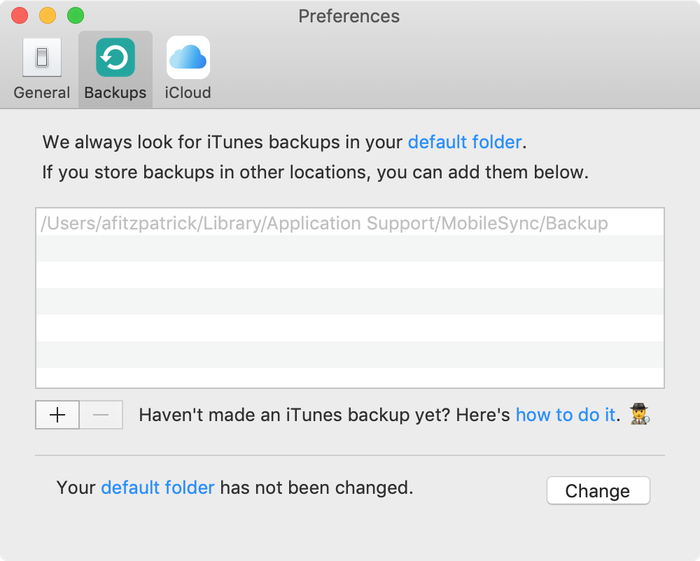
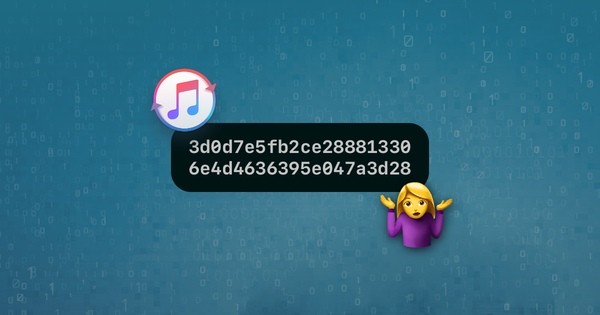

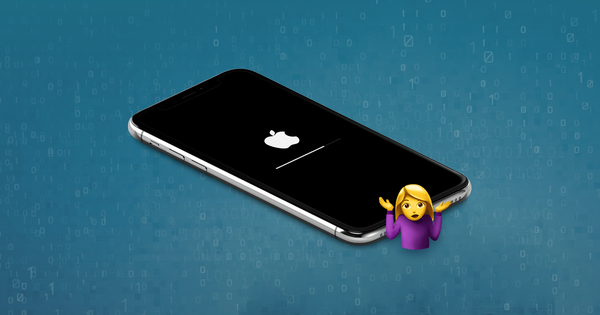
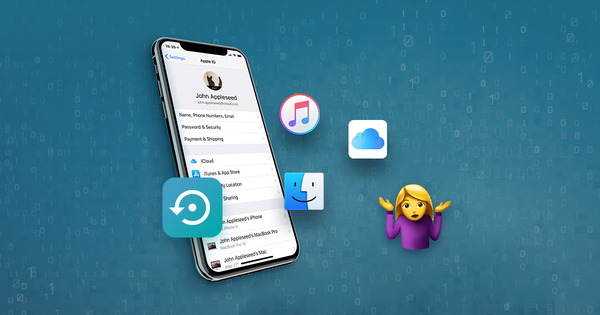

par Gael
Bonjour,
J'essaie tant bien que mal de déplacer ce Backup et de créer un lien symbolique. Cependant, la seule réponse que j'ai est: illegal option -- /
Je vous laisse le chemin que j'utilise et si une âme charitable veut bien m'aiguiller. Merci :)
ln -s/Volumes/VERBATIM\ HD/SAUVEGARDE\ IPHONE/ ~/Library/Application\ Support/MobileSync/Backup ln: illegal option -- / usage: ln [-Ffhinsv] source_file [target_file] ln [-Ffhinsv] source_file ... target_dir link source_file target_file
répondre par: Reincubate Support
Salut Gael, merci d'avoir écrit! Le problème ici est l'espace ("") entre votre chemin et les barres obliques.
Il doit s'agir de
ln -s /Volumes/VERBATIM\ HD/SAUVEGARDE\ IPHONE/ ~ /Library/Application\ Support/MobileSync/Backup, et non deln -s / Volumes / VERBATIM \ HD / SAUVEGARDE \ IPHONE / ~ / Library / Application \ Support / MobileSync / BackupFaites-nous savoir si vous avez besoin d'aide! 🙂
par Alex
Backing up to remote Synology server (not local). All you need:
thanks
par Samuel Kwok
Exactly what I needed. I don't want to store on my MacBook as it takes 200GB. This allows me to move to a Time Capsule. I don't use Time Machine but I use Time Capsule as a network drive and another copy of the whole Time Capsule to another network drive.
répondre par: Reincubate Support
Glad it helped!
par Rick Galloway
I've got the symbolic link created, but my iPhone back up still goes to the original C: drive location. When I look on my k: drive, I do not see the symbolic link file subdirectory even though it said it was created.
répondre par: Reincubate Support
Hi Rick: the symlink should be in your C: drive, in
MobileSync, and calledBackups. It'd be that that points to the K: drive in your case. If you get stuck, why not use the functionality in iPhone Backup Extractor? It can do it for you, and it's in the free edition.par Colleen Gordon
How do I figure out the my desired new backup location path? I want to use an external drive.
répondre par: Reincubate Support
Hi Colleen, thanks for commenting. If you use the functionality in iPhone Backup Extractor to change location, you can make the change simply by browsing to the folder you want. That might be easier! 🙂
par Mike L.
A fix to the insufficient permissions error--
Since I got the permissions insufficient in both cmd and powershell. First you search
cmdand then right click the command prompt app and run as admin. Navigate to the directory using the cd command ex.(cd c:\users\youruser\apple\mobilesync). once in the directory you can use the (mklink /d backup [new directory]) command listed in the article. That worked for me.As a side note, when using the cd command to navigate remember that you will likely have to put any folders with a space in the name inside quotation marks ex.(
cd c:\users\"this user"\apple\mobilesync). hopefully this helps some avoid the hassle of having to figure out this process if you get that persistent insufficient permissions response.par Aaron
Hello Aidan!
So I'm trying to change the backup path on Windows, and of course get the "insufficient privilege" error in the regular Powershell. So I ran it as administrator by typing it in the search bar and it said it created the symbolic link to the location, so I restarted my PC & tried updating iOs but the backup still went through to the original location (my hard drive, while I wanna change it to an external one simply 'cause I don't have enough space left on the former, lol).
So I guess my question is: how do I run Powershell in the MobileSync window as admin/how do I get the one I open through the search bar as admin to go to the MobileSync folder location so I can properly create the symbolic link & switch it up? :/
P.S. I did skip step one if I'm being honest, but only did so 'cause I already found the location manually, then proceeded to follow the instructions w/ renaming the folder, etc. Might this be the reason why it's not working? If so, shall I re-rename it to its original "Backup" name and try it again with the 1st step? I doubt it since I can't get the Powershell to go to the MobileSync location while I run it as admin to begin with/can't change it without running it as admin in the aforementioned window...Then again what do I know, lol.
P.P.S. Does the admin-run Powershell not need the MobileSync path to be put in and can successfully render the switcheroo by typing the featured command right after the "system32" path? If so, what seems to be the problem?
I was hoping to update my iOS tonight, and am getting more & more frustrated as we speak. Sorry for the post being so jumbled, hope all's clear. Thanks for the help!
répondre par: Reincubate Support
Hi Aaron, thanks for the comment.
Yes, if you skipped step 1 your Powershell will be looking in the wrong folder, so it won't have created the symbolic link in the right place.
If you've already got a Powershell or command window open, you can make it change folder with this command:
cd %APPDATA%\Apple Computer\MobileSync(If it's looking at the wrong drive, you'll have to change drive by typing
C:.)We've reached out to you directly to help, but if anyone else runs into the same problem, we'd recommend undoing the steps you took, starting over, and making sure to include the first step. 🙂
par Mohamed
I tried it, the following error popped up .. Plz advise
répondre par: Reincubate Support
Hi Mohamed, it looks like you're using PowerShell to run the command. If that's the case, you must prefix you command with
cmd /c, so it's likecmd /c mklink, etc.par Sean
I'm trying to do this on Mac OS 10.14.6 (Mohave), but when I try Step 5, I receive a "Operation Not Permitted" message. Any ideas...?
répondre par: Reincubate Support
Hi Sean, thanks for commenting. On macOS Mojave and newer, you'll need to grant "Full Disk Access" to your Terminal in order to make the change. There's a how-to on how to do this for iPhone Backup Extractor here, I hope that helps!
par Max
Thank you for the article. Here are a few notes to help somebody.
CD(include space). Example:CD C:\Users\Username (change this)\AppData\Roaming\Apple Computer\MobileSyncmklink /d Backup "L:\Users\XYZ"par Joe
I'm still having trouble with permissions, when I open up powershell in admin I get a command line PS
C:\Windows\System32>I don't seem to be able to open it in admin mode from the file path of the itunes back up.répondre par: Reincubate Support
Hey Joe, you can change directory using the
cdcommand. Try this:cd %APPDATA%\Apple Computer\MobileSyncpar Jess
Thanks for this assistance! I too got stuck on the "you do not have sufficient privilege to perform this operation." I then followed your advice in the comments above and ran Powershell as an administrator, but the Powershell window that opens from the MobileSync folder doesn't seem to recognize that and keeps giving me the same message. What do I do from here? Thanks!
répondre par: Reincubate Support
Hey Jess, thanks for writing. It's the same privilege error you're getting? If you drop us a note I'm sure we can guide you through it.
par Андрей
У меня выдает ошибку в PowerShell mklink : Имя "mklink" не распознано как имя командлета, функции, файла сценария или выполняемой программы. Проверьте правильность написания имени, а также наличие и правильность пути, после чего повторите попытку. строка:1 знак:1 + mklink /d Backup "[desired-new-backup-path]" + ~~~~~~ + CategoryInfo : ObjectNotFound: (mklink:String) [], CommandNotFoundException + FullyQualifiedErrorId : CommandNotFoundException
répondre par: Reincubate Support
Привет Андрей, попробуй
cmd /c mklinkи так далее 🙂par Hogan
Hi Aidan, Thanks for your amazing instructions!
I have run them on my Mac but got an error saying "Library/Application Support/MobileSync/Backup: No such file or directory". I guess this happened because I have renamed the old "Backup" file. Actually, it also confuses me a lot when u say "Once the 'Backup' folder has been renamed.../Backup", as the original "Backup" file doesn't exist anymore(right?)
Looking forward to your further clarification. Thanks :)
répondre par: Reincubate Support
Hi Hogan, thanks for your kind words. That second "Backup" reference is assuming you didn't change the folder's name, but simply moved it elsewhere. If you did rename it, you'd want to change it in that command. I hope this is clear. If it's not, do drop us a note. (Or use iPhone Backup Extractor to move it for you, as the free version can automate this process.)
par Luna
hi i get this message when i try and finalize the path: "You do not have sufficient privilege to perform this operation." It's my computer and i understand it has to do with admin rights but how do i run windows powershell as admin?
répondre par: Reincubate Support
Hey Luna! No problem: on Windows, you'd click on the "Start" button, then type "powershell". You'll see the menu search eventually shows you the PowerShell icon. If you right-click on that, you'll see there's a "Run as Administrator" option. Good luck -- I've asked our support team to drop you an email directly in case you need further help. 🙂
par Cedric koh
If I were to delete the backup symlink in the itunes MobileSync folder,how will that affect the backup folder i used for the symlink in my other drive? Will the files inside the backup folder in my other drive be unusable?
répondre par: Reincubate Support
Hi, thanks for stopping by. Removing the symlink is safe: it will effectively just remove the pointer to the backup folder on your other drive. The files will still be usable, but iTunes (or Finder) won't know where to look for them.
You could then move the files back to where they were originally -- or create another symlink.
par PBHRider
Great work. How do you come up with this stuff? Did the manual method on Windows 10 using the command prompt with admin privilges and am now backing up my iphones etc to my NAS drive. Saving about 4Gb on my SSD on my laptop. Thank you.
répondre par: Reincubate Support
Really pleased it worked out for you. 👍 Don't be a stranger if you need help in future!
par Michael Milbourn
You do not have sufficient privilege to perform this operation. It's my computer, who is not letting me change things on it?
répondre par: Reincubate Support
Michael -- if you're on a Windows machine, trying running these commands in a Windows Command that has been launched with "Run as Administrator".
par Lucas
Works like a charm! I followed the instructions for manually changing the iTunes iOS backup folder on Windows (through PowerShell). It is exactly what I was looking for to free up space on my C: drive. Thank you so much Aidan!
répondre par: Reincubate Support
Our pleasure, we're glad it helped!
par Brad
Thank you for this
par kalveer kaur lehal
Hi thanks for this. I get an error saying:
Local volumes are required to complete the operation.
How can I fix this please? Thanks
répondre par: Reincubate Support
Hi Kalveer, this message suggests your filesystem is FAT-based. I've updated the article to include a mention of why it's not possible to create links on FAT. I've also included a link to instructions on upgrading to NTFS. Good luck!
par Greg
Awesome instructions, thank you! I think there is a typo on step 5 for Mac. The command line is written as
-s [desired-new-backup-path] ~/Library/Application\ Support/MobileSync/Backupbut the folder "Support/MobileSync/Backup" doesn't exist since we moved/deleted it. I had to change it to "Support/MobileSync" and then the folder I linked to was called "Backup".répondre par: Reincubate Support
Howdy Greg! Having "Backup" in the path should be correct, as it'll ensure the link that gets created is called "Backup". Makes sense?
We've got something up our sleeves to make this a little easier in future. Keep an eye on the release notes. 😏
par salma
hi ! i did all the steps but i kinda don't get where is the new backup location now ?
répondre par: Reincubate Support
Hi Salma -- the new location will be the folder you created the link to!
par Clint
Firstly Aidan - thank you very much for this.
My main drive is a (relatively) small SSD and I would like to be able to save my iTunes backups to the NAS setup instead. You have provided a fantastic workaround!
One thing I wasn't sure about was at step 3 (Windows) - when you right-click (to choose "Open PowerShell window here"), is that in the Explorer window of the now renamed Backup folder? Eg, in the now-named "BackupOld" folder window?
répondre par: Reincubate Support
Hi Clint, thanks for your kind words. I've updated the article to make it crystal clear: the window you right-click in is the one you opened at
%APPDATA%\Apple Computer\MobileSync.par Hugues Larouche
And how do you reverse it on Windows PC ? Thx
répondre par: Reincubate Support
Hugues, thanks for your comment. I've updated the article to explain that!
par Fred Brunson
Aidan, I don't understand your instructions in How to change the iTunes backup location. What do you mean by prefix your command in PowerShell with cmd /c, like mklink /J Backup "[desired-new-backup-path]".
répondre par: Reincubate Support
Hey Fred, thanks for asking. Just like this:
I'll tweak the explanatory text to make it clearer.